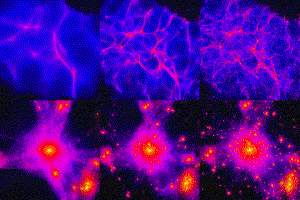Post
Profile Matching
11 October 2013
 University of Zurich
University of ZurichAs I’ve written about before, the existence of dark matter is well supported by observational evidence. There isn’t much debate in the astronomical community on the existence of dark matter and the fact that it makes up a large part of the mass of galaxies. We’d still like to have a direct observation of dark matter to be certain sure, but there is general consensus on dark matter.
This doesn’t mean there is uniform agreement on the nitty-gritty details. One of these details concerns the distribution of dark matter within a galaxy. Since we can’t observe dark matter in a galaxy directly, we must secondary effects such as the gravitational lensing of background light or the speeds of stars within their galaxy. Through these types of observations we can see the gravitational effect of dark matter.
If the gravitational effects were entirely due to dark matter, then it would be a straightforward matter to measure the distribution of dark matter in a galaxy. But the gravitational effects are due to the mass distribution of both dark matter and regular matter. This means we must subtract out the gravitational effects of regular matter to study the effects of dark matter. This can be done, but it takes much more effort, and it also depends on the assumptions you have about dark matter. In astrophysics we say the results are model dependent.
Just to be clear, this does not mean we’re doing something unscientific like assuming dark matter is true to prove that dark matter is true (circular reasoning works because circular reasoning works), but rather we have clear evidence of dark matter and are trying to match that evidence to a particular model of dark matter.
An analogy would be if we observed skid marks of a car, but had only directly observed bikes making skid marks. Based on the width and length of the skid mark, it is clear it was not caused by a bike. The skid mark strongly supports the existence of a car, but to calculate the speed of a car when it started to skid we have to make an assumption about the car’s mass. It could have been a light car going very fast, or a heavy car going much slower. Our estimation of the car’s speed is therefore model dependant.
There are several types of dark matter that have been proposed. The most popular is known as cold dark matter (CDM), which currently seems to best agree with observation on very large scales. It is also the simplest model in many ways. Alternatives include warm dark matter, which is often invoked by models trying to integrate dark matter with alternative gravity models (since current alternative gravity models alone don’t agree with the large-scale structure of the universe). Then there is hot dark matter (which includes neutrinos), although observational evidence excludes hot dark matter from being a major contributor of dark matter in galaxies. It could also be a mixture of different types, and without direct observational evidence we can’t be sure.
In 1995, Navarro, Frenk and White ran computer simulations of galaxies containing cold dark matter, and found that over time the dark matter tended to fall into a distribution of mass now known as the NFW profile.1 This model works very well on the scale of clusters of galaxies, and makes an excellent match to the large scale cosmic structure, but on individual galaxies it has a few problems. For example, simulations of the model predict more satellite galaxies around large galaxies than we actually observe. It also doesn’t match the motion of stars in smaller galaxies as well as we would like.
An alternative model develop by Burkert assumes that dark matter can reach a kind of thermal equilibrium.2 This gives rise to a slightly different dark matter distribution known as the Burkert profile, which matches small galaxies much better. There are other models as well, such as the Einasto profile that seems to work well.
With so many models, it might seem like we really don’t know much at all about dark matter, but this is not the case. In fact, a recent article in Astronomy and Astrophysics compared several profile models as applied to the data from four dwarf galaxies, and found that the models agreed very well.3
All of these different profiles make certain assumptions about dark matter. By determining which profile has the best agreement with observation, we gain clues on the nature of dark matter.
At least until we can make direct observations of dark matter particles.
Navarro, Julio F. “The structure of cold dark matter halos.” Symposium-international astronomical union. Vol. 171. Cambridge University Press, 1996. ↩︎
Burkert, Andreas. “The structure of dark matter halos in dwarf galaxies.” The Astrophysical Journal Letters 447.1 (1995): L25. ↩︎
Breddels, Maarten A., and Amina Helmi. “Model comparison of the dark matter profiles of Fornax, Sculptor, Carina and Sextans.” Astronomy & Astrophysics 558 (2013): A35. ↩︎